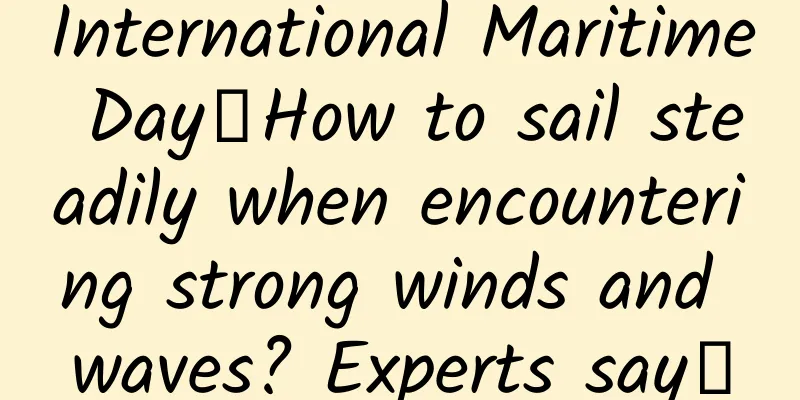International Maritime Day丨How to sail steadily when encountering strong winds and waves? Experts say→

|
The "strong winds and waves" mentioned in maritime navigation usually refer to strong winds and waves caused by cold waves or tropical storms (including severe tropical storms and typhoons). This is also a relative concept. For small and medium-sized ships, winds and waves of level 8 to 9 are considered "strong winds and waves", while for large ships, winds and waves of level 10 or above may pose a threat to the safety of the ship. Strong winds and waves have a great impact on the navigation safety of ships. They will cause the ship to sway violently, which not only affects the stability, buoyancy and strength of the hull, but also makes it difficult for the crew to work and accelerates fatigue. So the question is, how can we sail the boat safely in such bad weather? March 17 is "International Maritime Day" . Let's learn about maritime knowledge together. Copyright images in the gallery. Reprinting and using them may lead to copyright disputes. The number one enemy of ships: rocking In the early 19th century, a group of Napoleon's soldiers marched in majestic and uniform steps across a bridge in Angers, France. When the soldiers marched in unison, the frequency they generated coincided with the natural frequency of the bridge. When the group was about to reach the middle of the bridge, the bridge suddenly vibrated violently and eventually broke and collapsed, killing many people. Every object has its own frequency. When the natural frequency of an object is exactly the same as the frequency of another vibration, the amplitude of the object's vibration may reach the maximum. This phenomenon is known as "resonance". When resonance occurs, it often produces huge destructive effects. Are there any risks of resonance for ships sailing in the ocean? Yes. There are 6 types of motion when a ship sails in waves, namely rolling, pitching, bow rolling, heaving, swaying, and swaying. Among them, rolling and swaying are both reciprocating motions. Rolling is rotation around the x, y, and z axes, and swaying is linear motion along the x, y, and z axes. When the natural period of one or more of these 6 types of motion is close to the period of the wave, resonance will occur, increasing the amplitude of the ship's swaying. Ship 6 degrees of freedom motion Among these six types of motion, roll is the easiest to occur, has the largest amplitude, and has the most profound impact. When the natural period of roll is close to the wave period, harmonic roll will occur, and increasing the amplitude of roll may cause the ship to capsize. Therefore, harmonic roll is the number one enemy of ships. How to avoid harmonic rolling? We need to actively change the rolling period of the ship . For example, if the wave motion period is 7 to 9 seconds, we can adjust the course and speed appropriately to avoid this period and control the rolling period of the ship to less than 5 seconds and more than 11 seconds, thus avoiding harmonic rolling. If the bow is affected by waves, and the pitching period is equal to the wave period, the strong pitching will cause a lot of waves on the deck, resulting in the bottom-slapping phenomenon. What is the bottom-slapping phenomenon? It is when the bow rises and falls, and just hits the waves that are surging upwards, often accompanied by the sound of the hull and the waves hitting each other, and may cause the hull to vibrate and shake. In order to reduce the intense pitching: adopt sluggish navigation (deceleration or slow sailing against the wind), and adjust the route if necessary to avoid areas with severe sea conditions. "Z-shaped navigation" to deal with We all know that the shortest distance between two points is a straight line. However, in order to cope with wind and waves, ships sometimes have to take a zigzag route. In strong winds and waves, no matter what the wave angle (the angle between the bow and the wave direction, which can be head waves, side head waves, transverse waves, side following waves and following waves, etc.) is, it will bring danger to the ship. If you encounter head waves or side-head waves on the route, the relative speed between the waves and the ship will be large, and the impact of the waves on the hull will also be large. In severe cases, it will cause the ship to roll sharply, a large amount of waves on the deck, bottom hitting, and propeller idling. Z-shaped navigation Therefore, when sailing against the waves, it is generally necessary to reduce the speed and adjust the course. The most effective method is to use the Z-shaped navigation method, that is, to make the bow of the ship sail at an angle of 20°~40° to the wave direction for a distance, and then change to the oblique wave navigation method with a wave angle of 20°~40° on the other side of the bow. This can not only ensure a certain speed, but also reduce the swaying amplitude of the ship. The Z-navigation method is generally applicable to medium and large ships, especially large container ships. For small ships or ships that cannot withstand the impact of waves, the "drifting" method should be used instead. As the name suggests, this is a state where the ship's main engine stops and the ship drifts with the wind and waves. When a tsunami strikes, why do people walk towards the sea? On December 26, 2004, a 9.3 magnitude earthquake occurred on the seafloor near the Andaman Sea north of Sumatra, Indonesia, which shocked the world and triggered a super tsunami in the Indian Ocean north of Sumatra. The tsunami caused huge waves with a height of more than 10 meters, causing huge casualties and property losses. During this period, a bulk carrier was unloading at Chennai Port in southern India. When the captain was observing the water gauge (a gauge used to observe changes in groundwater level and tidal water level) on the side of the ship and returning to the gangway, suddenly, the entire ground and the dock shook violently, people could not stand steadily, and the ship crane on the side of the ship was also shaking dangerously. At this time, the captain shouted to the sailors at the ladder and jumped onto the gangway at the same time: "Quick, there is an earthquake, prepare the main engine!" At this moment, the entire dock sounded an alarm. The captain rushed to the bridge and quickly contacted the port authorities to send a pilot to leave the dock, but the communication was completely interrupted. At the critical moment, the captain did not hesitate and immediately ordered the sailors to untie the ropes and quickly board the ship. The chief engineer prepared the car and turned the bow to quickly head out of the port without the assistance of a tugboat. Just after leaving the dock, the ship's crane collapsed in the sea at the original berth. The captain knew that the earthquake would inevitably trigger a tsunami , so he ordered the ship to speed up and head for the deep sea. Two hours later, the bulk carrier was already on the vast ocean more than 20 nautical miles away from the port. At this time, the port of Chennai was in a mess. After the huge waves pushed towards the coast, all the ships that did not leave the dock lay on the berths in a mess. Why did the captain of the bulk carrier sail the ship into the vast ocean when a tsunami occurred? A wise captain must be very familiar with tsunamis: as long as there are no irregular huge waves in the center of the tsunami to directly destroy the ship, it is safe . This is the same as what we often say, "The eye of a tornado is the safest place." Tsunamis are huge waves caused by underwater earthquakes, volcanic eruptions, or underwater collapses and landslides. Generally speaking, if the energy of a tsunami only raises the water layer during its transmission and diffusion, even if it raises the water level by more than 10 meters, as long as the waves do not directly impact the ship, then in the vast ocean, the ship will still be in a good buoyancy and stability state, and the ship will float safely on the water, just "rising water lifts all boats". Therefore, when encountering a tsunami, the ship should quickly move away from the land and away from the tsunami site. If there is no time to hide, the ship should also urgently adopt the double anchoring method to reduce the impact of waves and keep the hull stable. Once the sea surface returns to calm, it should sail to the open sea as soon as possible. During the voyage in heavy winds and waves, the surging waves hit the bow and splashed onto the glass of the cabin / North Sea Fleet Pascal said: "Man is but a reed, the weakest thing in nature; but he is a thinking reed. ... The world around us is vast and infinite, but it is not as great as the spirit of the smallest human being." In fact, this principle can also be applied to sailing. On the boundless sea, a steel ship will become a small boat, fragile and swaying. Fortunately, the person who steers the ship will think, summarize experience, reflect on lessons, and then condense these into wisdom and courage to deal with and overcome the wind and waves - isn't sailing such a career? Planning and production Source: Condensation Author: Zhang Zhiyou, Director of the Science Popularization Base for Teachers of the Navigation Department of the Dalian Naval Academy Malt Yang Science Creator Editor: Zhong Yanping The cover image and the images in this article are from the copyright library Reprinting may lead to copyright disputes |
>>: Are black takeaway spoons poisonous? Do you still dare to use them?
Recommend
Information flow advertising: This is what pictures and texts with high click-through rates look like!
When you choose a channel , each channel will tel...
Why is it a false proposition that “everyone broadcasts live and everyone watches”
Live streaming is very popular, especially in Aug...
#千万IP创科普# Today in the history of science and technology | 1992·9·11 my country's low-temperature nuclear heating reactor refrigeration experiment was successful
On September 11, 1992, the refrigeration experime...
Start a course (completed) Didi Certified Senior Big Data Engineer Training Program
Start a course (completed) Didi Certified Senior ...
Here are all the ways to choose grapes that the fruit shop owner won’t tell you!
Now is the season when grapes are put on the mark...
Where is a bird's nose? What is it used for?
There are news reports, Seagulls circling over th...
A brief talk about user operations, my AARRR model!
1. Start by reconstructing the AARRR model After ...
Apple iOS 15/iPadOS 15 developer preview/public beta Beta 7 released
On August 26, Apple pushed the iOS 15/iPadOS 15 d...
Scientific Exploration丨China’s first major rescue: How to find an escape route for whales away from human interference?
At 5:30 in the morning of April 20, the rising su...
White UI design is not the only minimalist design
Since the products of several Internet companies ...
Ling'er Investment Research Diary "Golden Buying and Selling Points" Gold Buying Points & Gold Selling Points Private Edition
Ling'er Investment Research Diary "Golde...
8 tips for Facebook advertising!
Because I am not familiar with Facebook's adv...
Apple slows down old iPhones, but Android phones call it "artificial intelligence"
The following content may cause discomfort to a l...
Why is the conversion rate so low?
"What would you like to drink? I want Coca-C...









